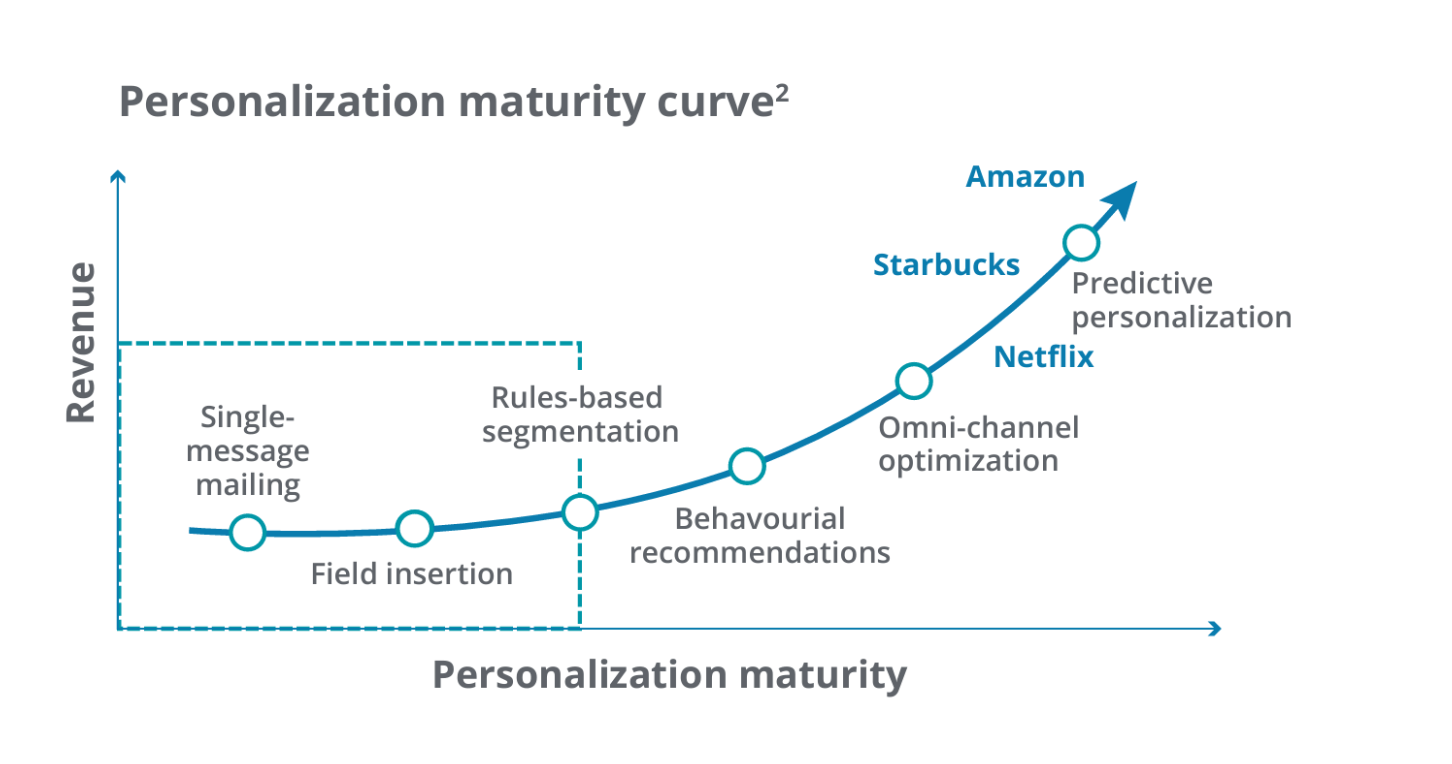Personalization with precision: The next era of CPG marketing
July 17, 2023

Marketing for mass appeal is a relic of traditional CPG engagement strategies — especially when we know better (and can do better). Modern businesses already have the data they need to personalize with context, more easily, and more meaningfully than has ever been possible.
To personalize 1:1 experiences at scale, you need to be able to pinpoint your customer, layer on consumer insights for smart targeting and segmentation, and activate across your marketing channels. That’s the future of CPG marketing — and it’s already here.
Achieving personalization maturity starts with data
With today’s customer expectations as high as they are, CPG brands need to be able to count on their data to deliver value and inform better-than-ever personalization strategies.
Together, data quality and data accessibility make 1:1 personalization possible on a broad scale — but the brands that are most advanced in their personalization maturity ahead of 2024 are the ones investing in the necessary tools, skills, and infrastructure that power such precise levels of targeting, segmentation, and relevance.
According to research from Deloitte, businesses with the most mature personalization strategies are leveraging:
- Rules-based segmentation,
- Behavioral recommendations,
- Omnichannel optimization,
- And predictive insights to tailor their customer experiences.
Even better? This investment in personalization maturity is paying off. Personalized, 1:1 marketing can reduce customer acquisition costs by as much as 50%, lift revenues by up to 15%, and increase marketing ROI by 10-30%.

Source: Deloitte
To make this kind of business impact, though, many CPGs will need to rethink their approach to personalization altogether. Here’s why.
The individualization of personalized customer experiences
If you don’t know your customers deeply, or can’t —for example— distinguish between customers in one household sharing a single device, it’s near-impossible to get 1:1 personalization right.
According to Forbes:
- Over 70% of consumers only interact with personalized messaging.
- 66% of consumers admit that coming across content from a brand that isn’t personalized would deter them from purchasing.
- Seventy-two percent of shoppers say they expect the businesses they buy from to not only recognize them as individuals but also to know and tailor experiences to their interests.
Although a surface-level or fragmented view of customers continues to plague many organizations, customers themselves are refusing to stand for it. So, what can you do about it?
How Lytics CDP can supercharge your personalization maturity
Today, a sophisticated, predictive, and customized new marketing agenda is enabling leading CPG marketers to fulfill their new growth mandate. But it’s not true for all CPGs.
- According to a report by Gartner, only 50% of CPG companies have a defined data and analytics strategy in place.
- And only 40% of consumer goods companies that have made digital and analytical investments are generating adequate return on investments.
So, among those who are getting personalization right, what’s the secret to maturity? Checking the boxes across these four elements:
1. A unified customer view with predictive and prescriptive insights
With Lytics, say goodbye to pesky data silos and lean confidently on data you can count on. Not only can you embrace a 360-degree customer view and resolve known and unknown customer identities with ease, but also, Lytics tags content and tracks interactions with it to accurately predict other content (or products) that will resonate with your customers.
2. Advanced segmentation and targeting (including lookalike modeling)
Easily build highly segmented audiences based on user behavior and interests for more personalized marketing. Lytics automatically updates your audiences as candidates newly meet or no longer meet your specific criteria, taking the manual hassle of audience creation off your plate.
Define customer and prospect segments that you want to replicate, and let Lytics machine learning algorithms identify similar audiences to target with appropriate experiences – throughout your martech stack.
3. Capabilities for personalized omnichannel activation
Your customers tell you what they want and how they expect to be served with every tap, scroll, and click in your app, website, and emails. Lytics collects this data, providing first-party behavioral insights: ones that are, on average, 86% more predictive of customer action than third-party demographic data.
Lytics uses data science in conjunction with our AI-powered decisioning engine to analyze your first-party data and offers insights within a week. Those insights can then be used to inform strategy and drive business results, allowing you to offer up timely and relevant recommendations across channels, deepening engagement and driving revenue.
4. A fit-for-purpose data and tech stack that can boost ROAS
With Lytics, you benefit from a privacy-centric, composable CDP, perfect for personalizing customer experiences with precision, that fits your business infrastructure and meets your business needs (even as they change).
CPGs lacking the right tech and tooling often have to use paid media or owned media properties to create a value exchange and acquire first-party data. The result is that each consumer gets a fairly generic or similar message, which ends up resulting in a low conversion rate. Lytics can be used to make that process more precise.
Using machine learning insight, CPGs can better predict action by assessing whether a prospect shows positive or negative momentum or behavioral signals. In turn, they can then suppress messages or ads to those showing low levels of engagement. For one Lytics customer, this meant dropping their CPA from $201 to $186.
CPGs — turn customer data into actionable insights
Data you can count on is the key to unlocking accelerated business growth, and making that data accessible across your organization means that — while your data teams focus their time on AI/ML modeling, your marketing teams can independently run and optimize campaigns based on actionable data insights. In the end, this means happy customers who are likely to repurchase to recommend your brand.



